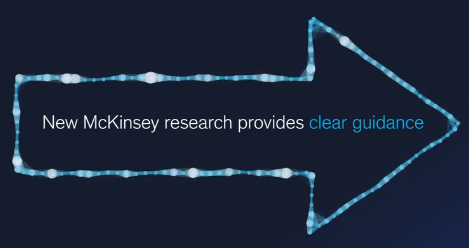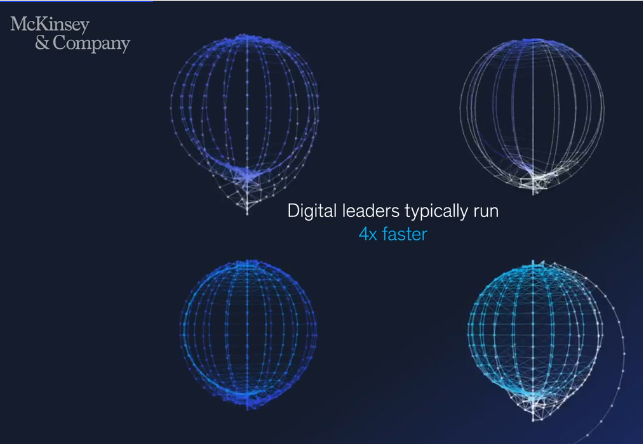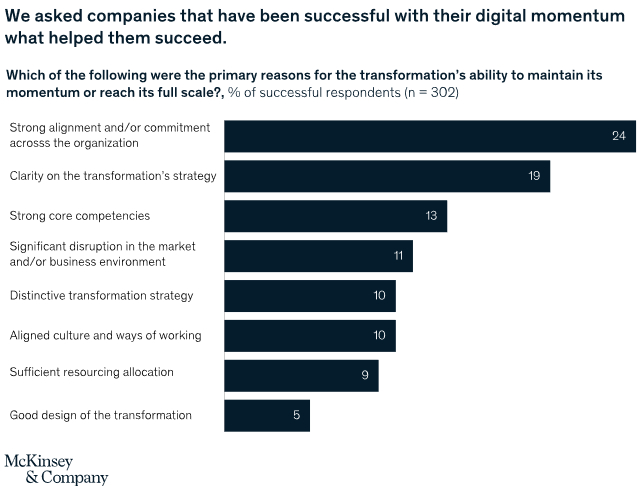
To succeed in the digital age, companies need to significantly raise their metabolic rate

In this episode of the Inside the Strategy Room podcast, we share McKinsey research on how fast and boldly companies need to move to win in the digital era, and describe some common pitfalls in digital strategy and ways to avoid them. This is an edited transcript. For more conversations on the strategy issues that matter, subscribe to the series on Apple Podcasts or on Google Play.

39:45 Audio ” Strategy at the speed of digital” in https://www.mckinsey.com/business-functions/strategy-and-corporate-finance/
Podcast transcript
Sean Brown: From McKinsey’s Strategy and Corporate Finance Practice, I’m Sean Brown. Welcome to Inside the Strategy Room. In this episode we discuss how digital leaders execute strategic moves with a speed and power that far exceeds those of their peers. I’m joined by co-authors of a recent McKinsey Quarterly article, “The drumbeat of digital: How winning teams play.” Tanguy Catlin is a senior partner in our Boston office who focuses on digital strategy and insurance clients. Laura LaBerge, based in Stamford, Connecticut, is a member of our digital strategy team. It’s my pleasure to welcome you both.
Laura, let me start with you. You and Tanguy previously wrote about pitfalls that cause digital strategies to fail. How does this new research expand on that?
Laura LaBerge: We started by looking into what is really known about disruption. It isn’t new—it’s been happening for centuries. Prior to digital, incumbents typically experienced a survival rate of less than 20 percent during extreme disruptions. So, we asked more than 2,000 organizations how well prepared they felt to navigate the current change, and 92 percent did not feel their current business model would be economically viable as digitization progressed. Tanguy and I wanted to understand why digital is so hard. We looked at organizations attempting large digital transformations and surveyed thousands of companies implementing digital change at various scales and with various degrees of success.
[…]
Sean Brown: Given this winner-takes-all scenario, how should an incumbent invest in digital? It seems to imply that you have to go big or go home.
Tanguy Catlin: You’re exactly right. Companies need to move faster and be bolder. Bolder might mean repositioning yourself on the chess board, and that involves M&A—both acquisitions and divestitures. And it’s a game of musical chairs, so you need to make sure there are still chairs for you and move faster toward your objective.
Laura LaBerge: Not only do you have to move faster but move first. Even five years ago, being a fast follower versus being first mover—there were differences between those strategic postures, but the outcomes were not drastically different. Now, being a first mover or extremely fast follower is starting to have significant economic benefits. Part of the reason is the rate at which organizations can learn with digital. In the past, it was often six months after a product launch that you would do the postmortem to understand what was working and what wasn’t. Now you can have three-day iterations. This causes is a rapid divergence. The first mover, rather than being on version 2.0 when someone offers a me-too product, is on version 40. This, combined with network effects, gives first movers a huge advantage. If you are first to lock in strategic partnerships, in many cases, just from a scale perspective, you win.
[…]
Sean Brown: What implications does your research have for midsize companies that may not have the resources to pursue large-scale M&A to acquire digital capabilities?
Laura LaBerge: Actually, a large percentage of the companies we surveyed were midsize organizations. Obviously, they are not doing M&A on the same scale as some huge incumbents, but we also saw that when M&A isn’t an option, partnerships are. You can partner in more strategic ways to gain digital capabilities.
Tanguy Catlin: The emergence of ecosystems creates many opportunities, just as eBay created a marketplace that all of a sudden allowed small and midsize enterprises a way out of competing on marketing to get exposure to customers. You don’t need to be the architect—the eBay—of the ecosystem and still find a marketplace that allows you to reach millions of customers.
About the authors: Sean Brown is McKinsey’s global director of communications for strategy and corporate finance and is based in the Boston office, where Tanguy Catlin is a senior partner; Laura LaBerge is a senior expert in the Stamford office.
More: www.mckinsey.com/business-functions/